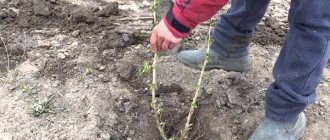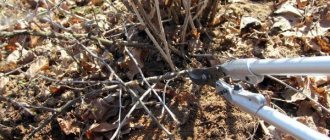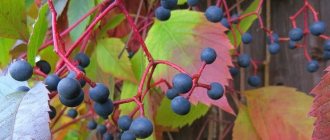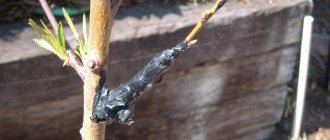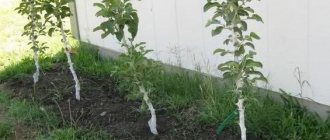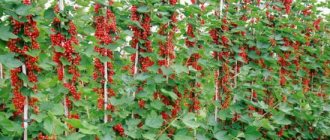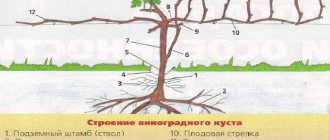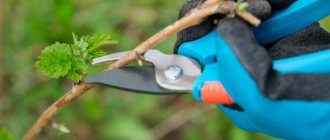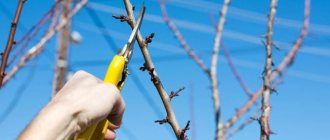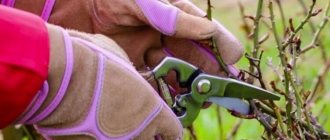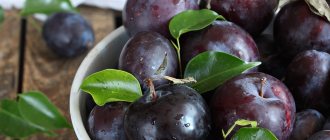Why do you need to prune blackberries in spring?
Using prunings, they try to form bushes, but as for blackberries (the closest relative of raspberries), this is not the main goal of the procedure, since ground shoots exist for no more than 2 years. The main focus is thinning, because the scourge of the blackberry itself is its actively growing shoots.
In addition to thinning, the method of shortening last year's branches by about 2 pairs of leaves is also used. This will help improve the quality of future fruits, and will also stimulate the appearance of side branches on which berries will appear.
Every spring it is necessary to remove excess branches so that they do not compete with fruit-bearing ones for the right to receive nutrients from the soil.
We recommend reading these articles:
Treatment of aloe seeds before sowing reviews
Disinfection of seeds before planting at home
How to speed up the germination of sweet pepper seeds
Each pruning is a regulation of physiological processes occurring in the plant. In this way, the gardener indirectly controls the transport of the flow of useful components inside the bush, directing them in the right direction.
Often timely pruning of garden blackberries in the spring helps save the plant from frost. This procedure will delay the development of the above-ground part of the bush for at least a week and make the plant more resistant to disease.
Preparing blackberries for winter
Despite the unpretentiousness of garden blackberries, preparation for winter is included in the mandatory list of agricultural care techniques.
Basic preparatory measures for winter:
- systematic watering before the onset of serious cold weather;
- thinning of blackberry plantations, where there is pruning of last year's shoots and shortening of current shoots;
- fixing the lashes to a standing structure;
- formation of bushes, making it easier to prune shoots;
- loosening the root space and removing weeds.
Autumn fertilizing is of no small importance. If ammonium nitrate is added during the growing season, then in the fall preference is given to potassium-containing additives without chlorine (25-30 g per plant)
Superphosphate is also suitable in the amount of 120 g per bush. The berries respond favorably to organic matter: 5 kg are added to each bush and loosened with a pitchfork.
Important! Before introducing any fertilizing, blackberry bushes are pre-moistened abundantly.
Blackberry formation
Shaping the plantings is one of the most important components of care, which makes it easier to cover blackberries for the winter and pruning. The procedure varies depending on the variety of blackberry: erect, creeping, remontant.
Features of molding upright blackberry varieties:
- Raise the lashes and fix them on a vertical support (trellis).
- Newly formed shoots are tied with wire from below, at an angle.
- Lignified shoots are placed in the center, then it is easier to find and trim them in the fall.
- From the young vines that grew during the warm season, up to 10 of the strongest are selected, the rest must be cut to the base.
- Green shoots are cut into quarters.
Creeping varieties of blackberries do not overwinter well without shelter, but they are much longer than other representatives - they stretch up to 10 m. It is recommended to identify a dozen viable shoots in the spring that will remain for the winter, and gradually cut off the rest. If you do not do this in advance, then in the fall the bush will become so tangled that it will be problematic to cope with it.
To do this, after winter, old branches are attached to the wire on one side, and young ones must be fixed on the other. Then in the fall it will not be difficult to prune the old ones and thin out the young ones.
Do they cover blackberries for the winter?
The culture is not frost-resistant, so covering blackberries for the winter, especially in central Russia, is vital. There are some cold-resistant varieties, but even they freeze when the thermometer drops to -20 °C.
The process of providing blackberries with acceptable conditions for wintering is responsible and labor-intensive. If this is not done, then there will hardly be a harvest next year.
How to cover blackberries for the winter
Upon completion of preparations for winter and pruning, the blackberries must be provided with appropriate shelter. The shoots are first arranged in bunches, planted and secured in any way. But similar manipulations are easy to apply to creeping varieties of blackberries, and the approach to upright ones will be a little different.
Advice! Place blackberry shoots on an adsorbent base: boards, polystyrene foam.
Woody stems of bushes break easily if you start bending them sharply. Therefore, at the end of the summer season, a sinker is tied to the apical part. Under their weight, the shoots will begin to bend on their own. After leaf fall, in late autumn, blackberry stems are helped to bend more manually. After which they are covered for the winter.
The following is used as covering material:
- fallen leaves;
- coniferous spruce branches;
- any substandard vegetation from the personal plot;
- wood shavings, straw;
- humus;
- peat;
- roofing felt sheets.
To contain the snow pressure so that it does not damage the bushes, it is recommended to build a dome-shaped structure, as well as stretch a film or agrofibre on top.
Recently bred remontant blackberry species are the easiest to cover for the winter
In the fall, it is important to prune at the root, then cover with hay or other garden insulation. Remove protection with the first warmth of spring
When is the best time to prune blackberries?
Pruning in spring, autumn and summer is carried out for various reasons, and has a beneficial effect on the condition of the bush. Spring pruning is carried out to remove branches that died during the winter. Thin, blackened and dry branches are removed. Pruning in autumn prepares the bush for the winter cold. Sanitary pruning in the fall includes the removal of all old and non-viable branches. In autumn, branches affected by pests and diseases are removed.
How to prune a blackberry bush in the fall: video
Blackberries are a fastidious shrub that requires careful care throughout the growing season. It is customary to remove branches from a bush in early spring before the first leaves appear, as well as after harvesting the last harvest before the onset of night frosts. To prevent pruning blackberries in the spring for beginners or in the fall from becoming problematic, you need to arm yourself with the simplest agrotechnical knowledge.
Autumn work in the garden
Blackberries belong to the fruit-bearing shrubs of the Rosaceae family. Its crown consists of young annual and lignified biennial shoots. In erect and creeping species, berry ovaries are formed on overwintered branches, and in remontant varieties - on all.
Otherwise, the tangled crown will make harvesting difficult, and the old growth, when it dies, will absorb the maximum amount of nutrients, significantly slowing down the process of fruit formation. Some farmers doubt whether blackberries should be pruned in the spring. It is worth assuring them that shoots are removed twice a season: before buds open and in the fall. Spring pruning allows you to increase the yield and vegetation of the plant.
Is it possible to prune blackberries in May or early June?
Gardeners often ask this question, because the bush begins to bloom in June, and fruit ovaries form only in mid-summer. It is preferable to form early-ripening blackberry bushes in early April; pruning late-ripening varieties is permissible at the end of spring. Shoots damaged by frost and deformed by the wind are cut off from the bushes. If after this there are more than 8 branches left on the bush, gardeners choose the strongest and strongest of them.
Fruiting will occur on last year's shoots, and the young shoots that will form in the current season will bear fruit next summer.
Video with a story about spring pruning.
Autumn pruning after fruiting
In the fall, all last year's branches and those damaged by insects are cut off at the root. There should be no stumps left at the site of the layering. They, like dead shoots, will draw forces onto themselves and slow down the development of the bush. From the new growth in the fall after fruiting, the strongest stems are selected, no more than 8-10 pieces. For upright varieties, they must be shortened by 1/4 of the total length.
For erect varieties, the best option is 4-5 young shoots, for creeping varieties – 8-10. You can add 1-2 branches to the indicated quantity for insurance. After winter shelter, some may become damaged.
The dates for autumn haircuts are September or October. Work is carried out after harvesting. Both spring and autumn pruning are important for the plant. It is not recommended to skip one of these procedures, since an untidy crown can cause the death of the entire fruit-bearing perennial.
Sprout Removal Tools
The bark of most cultivated species of blackberries and wild plants is studded with large thorns and prickly bristles. This makes gardening more difficult and requires special equipment. The shoot removal kit includes the following tools:
- pruner;
- lopper (for neglected bushes with telescopic handles);
- rarely - a garden saw.
The gardener will need protective gloves, sleeves and a rubberized apron. The cut areas are treated with garden varnish.
When to prune blackberries in spring, in what month: optimal timing
As a rule, spring pruning of blackberries begins almost immediately after the snow melts, when the minimum positive temperature during the day (+5 degrees) sets in and the plant begins to slowly wake up.
By the way! There is an opinion that it is much more convenient to prune after the buds have opened and small leaves have appeared, because you can immediately understand which shoots are frozen and should be subjected to sanitary pruning, and which ones do not need to be touched.
Now, regarding the approximate dates when you can start pruning blackberries in the spring in the regions:
In the South, this is March-early April.
In the middle zone (Moscow region) - the second half of April - early May.
In the Urals and Siberia - from early to mid-May. Around the same time, blackberries are pruned in the North-West (in the Leningrad region).
Dates
Blackberry bushes need to be thinned after the harvest is complete. The approximate processing time is in the first months of autumn. Beginning gardeners are recommended to start the procedure as early as possible. Pruning can take a long time.
It is important not only to completely treat the bushes, but also to allow the plants to recover. After pruning, you need to have time to fertilize and provide shelter before wintering. Doing this for plants with fresh “wounds” is unacceptable.
The first pruning of the bush must be carried out 2 years after planting the plant in the country
When starting pruning, it is worth considering the type of plant. Thus, remontant blackberry varieties must be completely pruned in the fall. In the spring, such varieties grow new fruit-bearing shoots, which greatly simplifies the care of the bush. At the beginning of summer, the top of the remontant variety is cut off at a height of about 1-1.2 m, which will lead to the growth of side shoots. Shoots growing outside the row are also removed. It will be of little use, because due to lack of light there will be no berries on them.
During spring pruning of blackberries, which is also called sanitary, it is worth tearing off, collecting and burning the leaves. Blackberries shed few leaves in the fall. Especially if the bush is protected from frost for the winter. If the foliage still remains on the branches in the spring, it is collected. Do the same with fallen leaves. According to reviews, the bush can become very painful if this procedure is not carried out. Many insects overwinter in fallen leaves. They contain a large number of spores of fungi, viruses and bacteria. Destroying weeds, leaves, and cuttings from a bush in a fire is a good prevention of blackberry diseases.
Important points for caring for blackberries
- Erect varieties of blackberries are formed in the shape of a fan, and the garter of creeping types is carried out in two ways: by weaving or rope
- Weaving is very similar to rope, the only difference is that when weaving, the shoots are divided into two parts and twisted together. This method of gartering makes the plant more stable and is suitable for those varieties whose branches grow very large. For a variety with short shoots, the rope method is suitable.
- The most suitable variety for easy cultivation is considered to be creeping and thornless. The lashes unravel easily and are easily rolled up for the winter
- As the branches grow, it is necessary to trim the top to stop the growth in length. This method increases productivity, since without pruning the plant devotes a lot of energy to growing long shoots.
- The ideal variety is a remontant one. Requires autumn, complete pruning at the root of all shoots. For the winter, the root is covered, and in the spring the plant produces new shoots that will bring a harvest for this year. The variety is convenient because it has an annual cycle.
Pruning blackberries in the spring of remontant species
Pruning is the simplest. All shoots that have grown over the summer are cut off at the root and covered for the winter. In spring, the bush will delight you with new, abundantly flowering branches.
Another way to prune blackberries in early spring. The method involves pruning young shoots to increase yield. Pinching rules:
- One-year young shoots are pruned by 10 cm only after they reach 1 meter. After pruning, lateral shoots begin to actively develop.
- After they form the main shoot, they are shortened by half a meter.
- By following these simple tips on how to properly prune blackberries in the spring, the plant will develop well, forming a luxurious bush, and will thank you with a rich harvest.
There is no bush in the garden more thorny than the blackberry. This is the main problem in crown formation. Properly thought out planting will help facilitate further care. For blackberries, as for raspberries, a plot is allocated that is separated from other plantings by a reliable box. Supports are placed along the edges of the structure; they are necessary for the construction of the trellis.
To ensure free access to each bush, maintain the required distance between the bushes. Upright varieties are planted at intervals of 3.5 m, creeping varieties - 4.5 m. This arrangement allows the shoots to be freely attached to the trellis, which greatly facilitates pruning and covering the bushes for the winter. Methods for forming blackberries are in the form of weaving, fan or rope.
Choosing a time for landing
If you are wondering how to grow blackberries in the country, then first of all you need to choose the right time.
Unlike many berry crops that tolerate autumn planting well, blackberries need to be planted only in the spring, otherwise they will probably not take root.
The optimal time for planting is the end of April or the beginning of May. However, this largely depends on the region and the weather in a particular year. It is necessary that the earth warms up completely, otherwise the plant will not take root, will not acquire a developed root system and will simply dry out.
Pruning thornless blackberries in spring
To make caring for the crop easier, many summer residents prefer to grow special thornless varieties of blackberries. As the name suggests, the main feature of the culture is the absence of thorns on the shoots. This greatly facilitates the care of the crop, but there are other features that should be taken into account when growing this crop.
Firstly, seedlings should be placed at a distance of 2.5-3.5 meters from each other. Secondly, the trellises for the garter are pulled no lower than 2 meters from the ground surface. In addition, it is important to consider that thornless varieties are very responsive to fertilizing, which should be applied in early spring and during the formation of ovaries. Otherwise, caring for thornless blackberries, including pruning, remains the same as when growing traditional varieties with thorns
We recommend reading these articles:
Planting verbena seeds for seedlings in 2021
Pruning pears in spring for beginners in pictures step by step
Pruning grapes in spring for beginners in pictures step by step
Description
Let's start with the fact that blackberry is a low-growing shrub, more often it is a shrubby vine with a perennial root and a flexible stem. The latter is strewn with small sharp thorns. Although today, thanks to many years of work, breeders have managed to create varieties that are devoid of thorns and at the same time resistant to many diseases and pests, ensuring stable yields. If there is suitable support, the stems can rise to a considerable height, up to a couple of meters.
The culture is a honey plant. Their flowers are white, large, up to about three centimeters. Flowering is observed from June to September. The fruits are juicy, black or have a bluish coating, and ripen from July to August.
Methods for forming bushes for beginner gardeners
Starting from the second year of blackberry life, bushes are formed. This is done to make it easier to pick berries and care for the plant. Shaping can be done in several ways. For beginner gardeners, the simplest are 4 schemes:
- Fastening the bushes to a vertical stake (without trellises). In this case, the garter can be of two types - with or without separation of the shoots of the previous and current year. In the first case, fruit-bearing annual branches are fixed to the support, and replacement shoots are left free on the ground. This scheme is also used for more efficient use of garden space.
- Alternating formation with division of the bush into two parts. Fruiting shoots are tied to a trellis on one side of the axis of the bush, and young branches are tied on the other side. Depending on the number of shoots, each row of wire can support one or several shoots. Premature young side branches are removed. After harvesting the berries, all fruiting stems on one side of the bush are cut off, and replacement shoots are tied up to replace them next year. This procedure is repeated every year.
- Alternating formation with garter of neighboring bushes. In this case, the division of the shoots is carried out as in the previous version. In addition, shoots of the same type are tied between neighboring blackberry bushes. This type of bush formation is much simpler than weaving, but it takes up a larger area.
- Fastening at different heights. Fruiting branches are sent along the upper wires, and non-fruiting branches - along the lower ones. When growing varieties with very long stems, they can be mounted on trellises in the form of a sinusoid in order to save space.
The last two schemes are preferable, since they involve the division of shoots by species. Since it is necessary to cut off all fruit-bearing branches in the fall, sorting the stems in this way makes them easier to remove.
Standardization of the number of shoots
When we talk about rationing, it means calculating the load of the bush and in 90% of cases it is a grape bush. Divide the plant mentally into 2 parts: roots and vines. The grape vine is a perennial. It can produce an infinite number of shoots. But the root provides nutrition to this entire mass.
If it cannot cope with the load, then the vines will turn out thin and weak, and the clusters will be small and not too dense. Therefore, the grape bush is normalized, that is, exactly as much above-ground part is left as the root system can feed.
Grape producers will always indicate the permissible number of vines and the load on them, depending on the characteristics of the variety. For example, a vine thickness of 5 mm allows for the presence of 2 shoots, and with a thickness of 10 mm, 8 shoots are allowed.
The blackberry bush has a completely different situation. The root system is perennial, and the vines are annuals or biennials, depending on the variety. And the root system forms exactly as many shoots as there are buds.
The last parameter depends on the fertility of the soil. On a weak vine, the harvest will not be large. If you decide to remove the weaker branches from the resulting branches, then simply direct the nutrients to the stronger ones. And this does not mean that you will greatly affect the harvest.
Therefore, applying the concept of “rationing” to blackberry bushes is simply meaningless.
Mistakes when pruning blackberries
The main purpose of pruning any crop is to maintain health and increase yield. But if the procedure was carried out incorrectly, the consequences can be negative.
To avoid this, it is better to take into account possible mistakes in advance when pruning blackberries:
- Compliance with deadlines: in the spring, pruning is carried out before the onset of consistently warm weather and the awakening of the buds. If you did not manage to carry out the procedure on time in the spring, it is better to postpone it until the fall, simply shortening some of the shoots.
- Removing irregular branches: it is important to remember that in the spring you cannot remove the young shoots of the current year, since it is on these branches that the ovaries and berries will form. After the snow melts, only old two-year-old branches are cut out.
- Frequency: it is advisable to prune blackberries not annually, but once every two to three years. This is necessary to preserve the species characteristics of the variety. If you prune your blackberries every season, you will end up with a very lush bush with small and tasteless berries. The only exceptions are remontant varieties, which should be pruned annually in the fall.
In addition, during the pruning process you should not leave a large number of fruit-bearing shoots: to obtain a bountiful harvest, it is enough to leave only 4-5 of the strongest branches. If there are too many shoots, the crop will not be able to supply them with sufficient nutrients, and the yield will decrease.
We recommend reading these articles:
Pruning an apple tree in spring for beginners in pictures step by step
Planting eggplant seedlings in 2021 according to the lunar calendar in the Moscow region
Pruning cherry trees in spring for beginners in pictures step by step
Blackberries in the photo
Often, experienced gardeners carry out this procedure in the spring, together with a garter to support the stems. This is convenient because the negative consequences after the winter period are taken into account: the degree of damage or disease to the plant. Many buds die at a distance of one meter from the ground, so leaving a length of 1.5-1.8 meters is not rational. In this case, the fruiting zone is affected. Therefore, it is necessary to cut off the stem above the first remaining dense formed bud. If this is necessary in order to preserve the bush, then the stems are cut to the required length, the main thing is that it remains possible to tie them up.
Stems that did not survive the winter and are frozen are completely removed.
Blackberry garter after pruning
Almost all varieties of blackberries need support and tying. The shoots of this crop have increased flexibility and fragility. If they are not tied, then during a thunderstorm or under the weight of ripe berries, the lashes can easily break. In addition, harvesting is extremely difficult, especially from thorny varieties. Blackberry plantings that are thickened and not tied to a trellis do not receive enough light and the harvest will be weak.
In spring, gartering is carried out immediately after pruning. In this case, young shoots are separated from old ones. This greatly facilitates the care of bushes, harvesting and subsequent removal of fruit-bearing branches. There are several schemes for gartering blackberries: fan, wave, rope.
- Fan. Fresh shoots remain in the center, and last year's lashes are evenly distributed on both sides (right and left) and tied to the trellis. It is allowed to leave all the old branches in one direction. The main thing is to separate them from the young animals. This method is convenient for upright varieties. Fan crown formation is recommended for beginners.
- Wave. Fruiting branches are directed in waves along the lower rows of the trellis, and young ones - along the topmost ones.
- Ropeway. The young shoots remain in the middle, and the old shoots are distributed on both sides in bunches (usually two). Weaving into bundles gives the whole structure more stability.
Features of caring for blackberries
First of all, it should be said that all blackberry varieties are traditionally divided into the following groups:
- Ordinary - the bushes have thorns, pubescence is observed on the leaves, the berries are as similar as possible to wild blackberries.
- Thornless - varieties that, as a result of cultivation, have no thorns on their branches. Such plants bear fruit well.
- Remontant varieties are varieties that can produce crops twice a year, depending on the climatic growing conditions. Some of them have good frost resistance and can be grown in regions with significantly lower temperatures in winter.
The drupe will grow well and produce a good harvest if:
- plant it in a sunny area where it will receive enough light and solar heat;
- the soil will be fertile and moist.
Simple
Growing and caring for blackberries is very similar to raspberries, however, black berry bushes grow more intensively and can destroy raspberry plantings, so planting them next to each other on the site is not recommended.
Garden varieties of berries require watering, fertilizing, weed removal, soil care, loosening and mulching.
Since the plant develops at a rapid pace, it needs to be provided with sufficient nutrition, which it receives from the soil. Young bushes need to be watered abundantly in the spring, and fruit-bearing bushes should be fed with urea.
You may be interested in information about the remontant thornless blackberry variety Prime Ark Freedom.
Remontantnaya
Varieties of this type may have slight differences in harvest time, fruit shape and taste. To obtain it, the bushes require a pinching procedure, which will be described in more detail later in the article. This blackberry tolerates wintering well, thanks to the peculiarities of caring for bushes in winter.
It is important to know that in the first year after planting, remontant bushes do not bear fruit. Thus, last year’s shoots, which overwintered in a shelter, can bear fruit in June, and this year’s shoots will begin to bear fruit in August. Remontant varieties do not grow to the sides; the bushes have a compact, erect appearance, reaching a height of up to 2 m
This blackberry is very demanding when it comes to watering and does not like drought; the soil under the bush must maintain constant moisture
Thus, last year’s shoots, which overwintered in a shelter, can bear fruit in June, and this year’s shoots will begin to bear fruit in August. Remontant varieties do not grow to the sides, the bushes have a compact, erect appearance, reaching a height of up to 2 m. Such blackberries are very demanding in terms of watering and does not like drought, the soil under the bush should maintain constant moisture.
The need for pruning and its effect on fruiting
Pruning blackberries is one of the most important stages of preparing for winter.
Blackberries are shrubs with a two-year fruiting cycle. This means that young shoots do not bear berries in the first summer. Appearing in the spring, they grow during the summer, become woody, then overwinter, and produce a harvest the next year. Subsequently, these shoots never bear fruit again, becoming useless from the gardener's point of view. Therefore, so that they do not take away the strength of the bush and do not choke the growth of new young shoots, they must be pruned.
Agricultural technology
Have you ever wondered why grow blackberries when you can pick them in the forest? Experienced gardeners will definitely tell you that they do this because the berries of cultivated varieties are much larger. You can install a trellis for them and then the bush will not take up much space, but will produce up to 20 kg of berries. Blackberry farming technology is very simple. To successfully grow a plant, you will need:
- choose the right area for planting;
- plant plants;
- organize watering, fertilizing and pruning the bush;
- prevent diseases and pests in a timely manner.
Blackberries grow as erect, vertical or trailing vines. If space is not an issue, then leave it to grow as is.
And if it is important to preserve the appearance of the site or you have limited space, then you can install a decorative lattice or trellis. This will make caring for the bush and harvesting easier.
Deadlines
Blackberries are planted in early spring. She tolerates this well, even if there are still spring soil frosts. But some varieties are recommended to be planted later: in mid-spring and even in summer. These are plants intended for the southern regions. You cannot plant them in the fall after the thermometer drops below -2°C. Bushes planted in autumn should be protected from frost. They, like raspberries, are laid on the ground and covered with a layer of mulch.
You might be interested in reading about what blackberries are compatible with on your site.
Site selection, site preparation
The area should be well lit by the sun. Preferred soil: loamy or sandy loam. Acidity level - 5.5–7.0 pH. Blackberries grow well in acidic or neutral soil, but not in alkaline soil. Before planting, make sure the soil is not too dense. Otherwise, dilute it with sand. Dense soil prevents the development of roots, and this is bad for the development of the bush as a whole.
Dense clay soils have very little organic matter - no more than 2%, so such soil must be diluted with organic fertilizers: rotted manure, compost. Mixing soil with straw also provides many benefits:
- air and water circulation improves;
- moderate soil moisture is maintained;
- nutrients are released gradually and delivered to the plant as needed;
- When organic matter decomposes, soil health improves because many beneficial microorganisms appear in it.
Avoid using wood by-products as fertilizers, such as cedar or cedar shavings.
They are not suitable for blackberries. The area should be completely free of weeds immediately before planting to prevent plants from competing for water and nutrients. Do not plant blackberries in soil that has been used in the last two years to grow tomatoes, potatoes, eggplants or peppers as they can transmit Verticillium wilt to the seedling.

